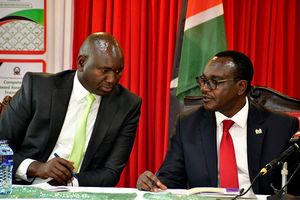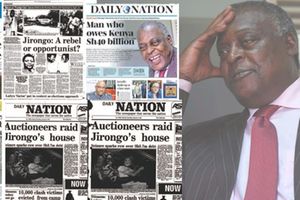Premium
Goldenberg roots and the mysterious saga of Saitoti’s poisoning, 33 years later

Then-Internal Security Minister George Saitoti during a presentation to the Constitutional Implementation Oversight Committee on President Mwai Kibaki’s stand on the appointment of the 47 County Commissioners at County Hall on May 29, 2012.
Some 33 years ago tomorrow — on the afternoon of February 13, 1990 — assassins finally caught up with Kenya’s Vice-president George Saitoti. The previous night, Foreign Affairs Minister Robert Ouko had been lured (some say pulled) out of his Koru home, brutally murdered and had his body burnt in a nearby hill, Got Alila.
As usual, Prof Saitoti, and a handful of close allies, had gone to the exclusive Indian food restaurant at the Muthaiga Shopping Centre in Nairobi.
It was a place he loved. It was quiet. Elitist. Great food and ambience gave him what he wanted — a secure environment away from the political madness and backstabbing of the Nyayo era.
Prof Saitoti loved Indian dishes. Had he known about Dr Ouko's disappearance the previous night, he would have been careful. But, as one of his close allies once told me, this was the only other restaurant in Nairobi where he would take food.
As the Vice-president, Prof Saitoti was a heartbeat away from the presidency. As a result, he was always cautious about the toes he stepped on — those he jumped and those he completely evaded.
Though a wonderful schemer, he did not love open political battles. He was a shy man and an introvert. In public, he looked timid, and though he looked rigid when dancing, Saitoti always walked very fast. That way, he thought he was always safe. He wasn’t.
Trusted bodyguards
To feel secure, he kept the number of friends and confidants at a bare minimum. Few would know where he was at any one time. He lived like a hermit. Prof Saitoti would hardly be found in Nairobi’s social scene. He evaded the city's social circuit, and for his security, he had retained the same trusted bodyguards for years.
There was the ever-present Inspector Joshua Tonkei, personal assistant Michael Tanju and a bodyguard named Sultan.
Those who observed Prof Saitoti’s political character thought it was odd for a highly successful politician to appear in flight mode. Even today, none of his friends has ever come out in the open to explain who Prof George Saitoti was.
So, when they finally caught up with him and poisoned his food, Prof Saitoti was at the place he trusted.
So frightened were his friends that after spending a few days at the Nairobi Hospital, they decided to turn one of his ooms at home into a ward with an ambulance always on standby.
One close source told me that it was only when he required some blood transfusion to clear the poison from the system that he would be taken back to the hospital.
Interestingly, Prof Saitoti’s illness, or poisoning, was never reported in the mainstream media, nor was his hospitalisation.
However, his disappearance from the public when Dr Ouko’s death was making international headlines was noticeable.
Bad state
Those who saw him say he was in a bad state and that his skin was literally peeling off.
So controlled was Prof Saitoti’s life that when he returned after a few months, he denied “rumours” that he had been poisoned.
He would later say that he did not know those who killed Dr Ouko because he “was unconscious when Ouko was being killed”.
It was after President Moi had told a public meeting — some years later — that the people who killed Dr Ouko were the same who “poisoned my Vice-President” that Prof Saitoti admitted that, indeed, he was poisoned.
As the Finance minister and Vice-president, Prof Saitoti found himself at the heart of complex transactions and powerful webs of deceit that he could never leave voluntarily.
Unknown to many, and perhaps — and I am saying possibly — not related to the poisoning, Prof Saitoti had received a note from a company known as Arum Limited suggesting that gold exporters be granted a subsidy to allow them to compete with smugglers.
There was also a push for a gold compensation scheme by mandarins stationed at the Office of the President.
In the few months to the June 1990 budget, Prof Saitoti was out of Treasury and recuperat ing at home.
It was then that the Commissioner of Mines and Geology wrote a letter to Arum Limited saying that an inter-ministerial decision was being awaited.
In the June 7, 1990 budget speech, Prof Saitoti announced that an Export Compensation Scheme would “be expanded and supplemented with an import duty exemption scheme”. How much he knew about this shift in policy as he was recuperating is not clear. If he knew something, as usual, he kept it to himself.
By examining the events that followed, we now know that the following month, Prof Saitoti received two people in his office: The head of Special Branch, James Kanyotu, and businessman Kamlesh Pattni.
The two had incorporated a new company, Goldenberg International Limited, and wanted to be granted 35 per cent export compensation.
Looting exercise
They also made sure that he knew they had been to State House to lobby for the same, according to an inquiry report into the saga.
The reason I have related the two events is that they formed part of the predicaments that would face Prof Saitoti later at the Treasury, where the Kanyotu-Pattni company engaged in a looting exercise.
Having survived death, Prof Saitoti had little room to maneuver and when one looks at the drama that followed, he was a man under siege. But that is not to say that Prof Saitoti was a clean man. Nay. He was thuggish in his way and was part and parcel of the cartels that ran that Nyayo system. Only that in that space, there are lions and jackals.
By approving the Goldenberg scheme — which snowballed into a monumental scandal — Prof Saitoti was trapped in a murky and frightening world where sleaze and skulduggery ruled. He had become one of the hydra-heads of corruption in the Nyayo era. The Goldenberg loot became the feeding tube to entities such as Youth for Kanu — a militia-like group that wanted the status quo maintained.
Life as Moi’s VP was hell for Prof Saitoti. Although he managed to build some solid networks within the system quietly, which he hoped to use post-Moi, he never showed his presidential ambitions. It was too dangerous. And as the Dr Ouko inquiry gained momentum, one of Prof Saitoti’s friends, Mohammed Aslam, the chairman of Pan African Bank, made the mistake of appearing.
Aslam, the brains behind the Grand Regency Hotel, now Laico Regency, was an insider in the Goldenberg scam, just like Prof Saitoti. Whatever he wanted to reveal was never known.
The Nyayo era had frightening moments— those who think it was a walk in the park should read its history of intolerance.
Some 33 years ago, Kenya’s vice-president was poisoned and made to keep quiet by a frighteningly obnoxious system.
*****
Postscript: On June 10, 2012, Prof Saitoti died in a mysterious helicopter accident. The brand new police helicopter went down after leaving Wilson Airport. Prof Saitoti was by then the Minister for Internal Security and was eyeing the presidency. Attempts to unravel the truth were not conclusive, and Prof Saitoti’s poisoning and accident remain the most mysterious events in his life. It was a sad end for a man who was too careful with his security. Lessons learned.
[email protected] @johnkamau1





